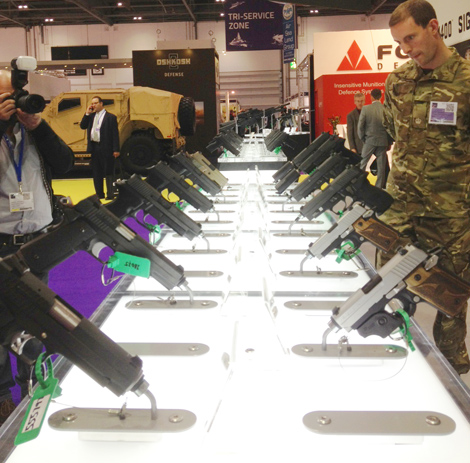
Take your pick: a line up of pistols from DSEi – the world’s largest defence and security event
Having looked at the heavyweight infantry carriers, stepping outside the DSEi show onto the banks of the Thames you are confronted by colossal naval vessels.
With the exhibition covering all military sectors, this is one of the few events where craft of this side can pull up alongside the main body of the exhibition hall.
What was key to note from the ships (on display from the Royal Navy and the corresponding navies from Germany, Holland, South Korea, Sweden) was the streamlined profiles and strange angles to make them more stealthy.

HMS Sutherland at sea, as opposed to being parked up in London’s docklands
All were equipped with impressive modern technology – Both Swedish ships were equipped for mine hunting and clearing with sonar; the Dutch ship HNLMS Groningen was loaded with fast raiding craft and helicopter for counter-drugs operations (it’s off to the West Indies next year as a guard ship).
The British HMS Sutherland is a Type 23 frigate used in proper maritime scraps. Toting Harpoon anti-ship missiles, Sea Wolf surface-to-air missiles, a medium range gun, and a new Wildcat helicopter, the vessel is one of the world’s most sophisticated submarine hunters.
Excitingly, a lot of Britain’s naval knowhow has survived to this day, with a plethora of UK-based companies on show. Not only are there giants like Qinitiq and BAE Systems, but smaller vessel builders like Marine Specialised Technology (MST).
Based in Liverpool, MST design and build specialist RIB craft using SolidWorks – manufacturing small, fully inflatable dinghies, to 12 metre long, 8-seater, drop-ready, rapid response craft for taking on nasty pirates, drug shipments or special operations – the type that the HNLMS Groningen is equipped with.
//www.youtube.com/embed/14uIyZ3931c?rel=0
Back on dry land there were firearms and even more coveted accessories.
As far as recognisable firearm brands go, Glock is high up there, and most interestingly the pistol frame and many components are made from high-strength polymer. Effectively ‘plastic’, these not only lead to impressive storylines in Luther, but also show up muppets that try to 3D print guns out of shitty FDM.
With multiple variables of calibre, weighting, and fittings, each pistol has to be modular and adaptable in its design, while being easy to manufacture and maintain.
More recognisable gun-making skills were to be found behind Steel Core Designs’ lovingly crafted sniper rifles (possibly the only thing ‘loving’ about a .50 BMG calibre weapon that can pop an enemy head off at over two kilometres).

The British designed and made Steel Core SC-127 Thunderbolt – deadly from over 2km away
Designed and built in Kent, the new SC-127 Thunderbolt was designed in SolidWorks and CNC machined.
The firearms business is not one that can be easily broken into. As the nice chaps on the trade stand explained, the success of a new rifle depends on it being picked-up on by special forces troops, where from it gain combat-proven status and would filter down to more general troops and bigger contracts for the manufacturers.
With this in mind you can see the extent that this small British firm has gone to in order to manufacture the ultimate sniper rifle – a tool-less attachable bi-pod; fluted barrels for improved heat dissipation and rifle balance; a two stage trigger with a predictable release and smooth operation; a fast lock action, and the ability to attach all manner of commercially available sights (and personalised fittings).
There was much, much more on show (including a Dassault Systemes stand looking slightly awkward amongst it all, rabbiting on about ‘3DExperience’ between a company selling ships masts and another selling pipe seals), including vast amounts of UAV technology which we’ve already looked at.

The new Eurofighter Typhoon, and its legendary predecessor the Spitfire – different generations of fighter plane
The exciting thing about DSEi is that it’s a full two years till the next show – plenty of time for the technology on show to advance further, and for that on show today to filter down to everyday applications.
As the contrasting scales of the Eurofighter Typhoon jet and World War Two Spitfire fighter plane displayed at the front of the exhibition, Britain has been designing and engineering technologically advanced weapons for hundreds of years.
In these lean times, whether you approve or not (and a lot of people don’t), the money from the defence industry means Britain designers, engineers and manufacturers can afford to operate – often in sectors such as medical and healthcare – which is only a good thing.






